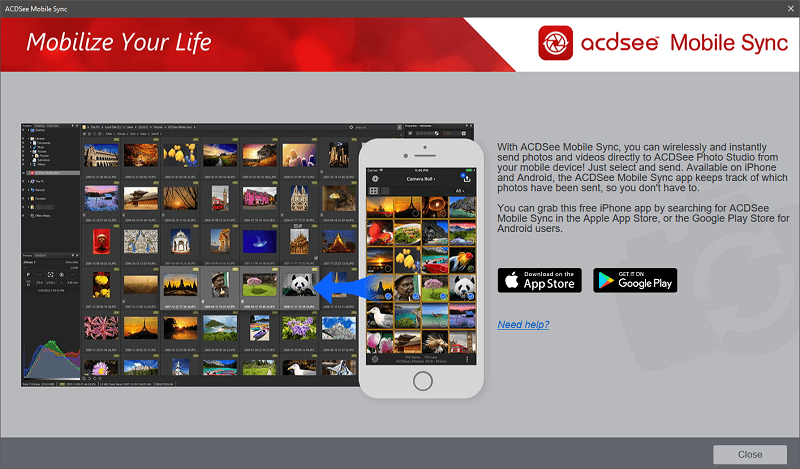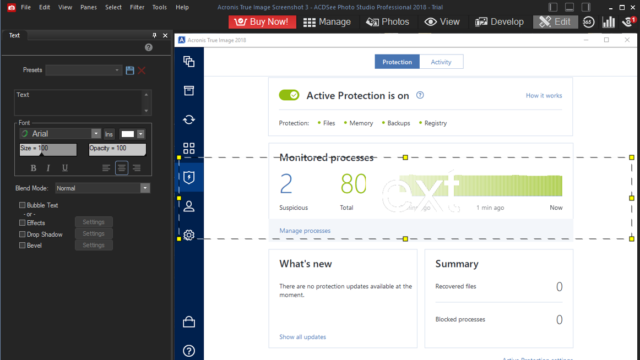

- #ACDSEE PHOTO EDITOR REVIEW MANUAL#
- #ACDSEE PHOTO EDITOR REVIEW SKIN#
- #ACDSEE PHOTO EDITOR REVIEW PRO#
- #ACDSEE PHOTO EDITOR REVIEW SOFTWARE#
- #ACDSEE PHOTO EDITOR REVIEW WINDOWS#
Its noise reduction isn't quite as effective, though, and its lens manual correction features are laborious.
#ACDSEE PHOTO EDITOR REVIEW PRO#
It's welcome but, again, we're baffled as to why there's still no History panel in Develop mode.ĪCDSee Pro 8 is responsive and powerful, and it matches Lightroom for library management and colour correction. ^ Pixel Targeting would work much better with an option to soften the edges of the selected areaĮdit mode also gains a History Window to make it easy to jump back and forth through edits. We'd much prefer to see it in Develop mode, where multiple filters could be used non-destructively and in tandem for precise colour correction. Yet again, it's a great idea, but the lack of a smoothing or feathering function often resulted in harsh or scrappy edges to the affected area.
#ACDSEE PHOTO EDITOR REVIEW SKIN#
It's also possible to target skin tones for inclusion or exclusion. However, the destructive tools in Edit mode go further than Lightroom's fully non-destructive toolset with features such as Text design, Tilt-Shift and various other creative filters.Įdit mode gains a new Pixel Targeting feature in this update, allowing filters to be applied selectively to parts of the frame depending on the brightness or hue of pixels. We've never liked this split in working methods as it limits the order in which filters can be applied and adjusted. Edit mode applies changes destructively to the original file, and generally concentrates on more creative edits. Auto EQ and Black and White are also available in Develop mode, and the other filters are located in Edit mode, filed under Special Effect, but they're not easy to find.ĭevelop mode handles non-destructive editing, which is ideal for colour correcting and removing noise from RAW files. Neither the Auto EQ nor the Auto Lens settings are applied permanently, and they can't be exported. Auto Lens provides a choice of four filters (Lomo, Orton, Black and White, Sepia), which are applied to all photos until the Auto Lens setting is reset to None. Auto EQ automatically corrects the photo's brightness and contrast, often performing well but making some photos look over-exposed. Here, there are two new buttons for applying quick treatments. ^ Auto Lens applies a choice of four effects, but it's a playback-only feature – you have to find the filters elsewhere in order to export themĭouble-clicking a thumbnail in Manage mode opens it in View mode. However, with 20GB online storage priced at £25 a year, there are various other cloud storage services we'd choose over this one.
#ACDSEE PHOTO EDITOR REVIEW SOFTWARE#
Online photos were slow to navigate, though, with the software locking up for up to 30 seconds while it waited for the server to respond. It appears as a panel in Manage mode and provides drag-and-drop access to folders located in the ACDSee 365 cloud storage service.

SeeDrive is another new feature that's better in theory than in practice. We also found PicaView to be temperamental, sometimes making the right-click menu disappear a split second after it had appeared. After reassigning file types to open in ACDSee Pro, files were represented by a generic icon. It's a great idea, but it’d be even better if photo thumbnails were also shown for the files themselves.
#ACDSEE PHOTO EDITOR REVIEW WINDOWS#
PicaView integrates with the Windows Explorer right-click menu to provide a large thumbnail and camera metadata for image files, including supported RAW files. The new features in version 8 are distributed throughout and even beyond the interface. ^ PicaView adds a preview and camera information to the Windows right-click menu SLRs are well catered for, but it's worth thinking about whether ACDSee Pro is likely to support the next camera you decide to buy.

^ With no lens profiles for automatic correction, it's not a great RAW editor for cameras that rely on this function, such as the Canon PowerShot G1 X II shown hereĪCDSee also lacks lens profiles for automatically compensating for lens distortions, which is a feature that Micro Four Thirds, and an increasing number of other compact system cameras (CSCs) and premium compacts, rely on for their RAW files. Fujifilm RAW is listed, but support for these files is limited, with none of the X-series cameras from the last couple of years supported. Various Panasonic and Sony cameras' RAW files are supported but it's far from up to date, with notable omissions such as the Panasonic Lumix DMC-GF6 and Sony A6000. File types are filtered according to their file extension, but there's no provision for Panasonic RAW files, and clicking Sony RAW draws a blank. For example, it’ll show all photos with a 1/30s or 1/60s shutter speed, but those with a 1/40s or 1/50s shutter fall between the gaps. The software maintains a list of all the cameras and lenses used in the library, but other metadata can only be filtered according to predefined values. ^ Library management is fast and effective


 0 kommentar(er)
0 kommentar(er)
